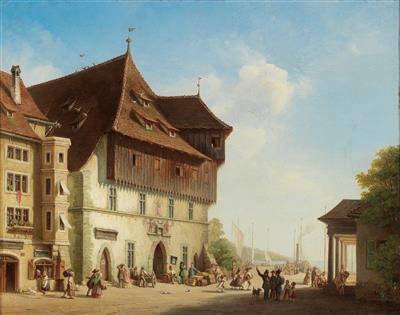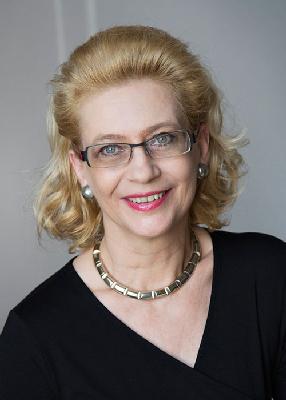Ferdinand Petzl

(Munich 1819-1899)
View of the Council Building in Constance, indistinctly signed F. Petzl, oil on canvas, 34 x 42.5 cm, framed, (Rei)
The Council Building in Constance was originally built in 1388-1391 as a warehouse and trading house, at a time when the city of Constance was developing into the most important junction on the trade route between Northern Italy and the Rhineland. Lying directly on the lakeshore and equipped with cranes for moving freight, it was easy to unload cargo ships and temporarily store the goods on the spacious ground floor. The upper floors offered space for the longer-term storage of dry and more delicate goods. During the Council of Constance, from 8 -11 November 1417, the warehouse became the setting in which the Conclave elected the pope intended to bring to an end the Western Schism which had begun in 1378 with the election of antipope Clement VII. This division in European Catholic Christendom lasted several decades. At the instigation of Sigismund of Luxembourg, King of Germany and Holy Roman Emperor, the Council was convened in Constance in 1414 in order to reach a settlement on neutral ground. It succeeded in persuading two of the three rival popes to resign, while the third, Benedict XIII, fled to exile in Spain. This cleared the way for the election of a new pope and thus to resolve the Schism. In preparation for the Conclave, the windows of the Constance trading house were sealed up with wooden boards, with the building enclosed by a fence and guarded in order to preclude any influence on the eligible voters inside. On St Martin’s day, 11 November, Oddo Colonna was elected as the new pope, and so he took this day as his papal name, Martin V. The building served as a warehouse and market hall until the 19th Century, before a new awareness of the significance of this remarkable mediaeval building developed in the early 20th Century. It was used as a concert and congress hall from 1910, and today is regarded as one of the city’s important landmarks.
Ferdinand Petzl, the Munich painter, specialised in architectural illustrations and vedutes. Accordingly, he studied at the polytechnic school, the precursor of today’s Technical University of Munich, and at the Royal Academy of Fine Arts. Many of his works document buildings or states of construction which no longer exist today; hence in addition to their painterly qualities, they also serve as valuable historical sources. His view of the Council Building in Constance shows it being used as a market hall and trading centre; barrels are being rolled through the pointed archway, goods in boxes and on handcarts are being delivered or taken away to be checked by a customs inspector wearing green. In the background is the harbour where several cargo ships are visible. The forecourt is bustling with activity. An elegantly dressed couple stand in front of the door at the left of the composition, studying the sign inscribed “Council Chamber”. This is clearly the entrance to the historically significant rooms in which the election of Pope Martin V was held in 1417. In the right foreground a guide also points to this sign, and appears to be explaining the importance of the place to the interested tourists.
Expert: Mag. Dimitra Reimüller
 Mag. Dimitra Reimüller
Mag. Dimitra Reimüller
+43-1-515 60-355
19c.paintings@dorotheum.at
24.06.2019 - 14:00
- Dosažená cena: **
-
EUR 3.840,-
- Odhadní cena:
-
EUR 3.000,- do EUR 4.000,-
Ferdinand Petzl
(Munich 1819-1899)
View of the Council Building in Constance, indistinctly signed F. Petzl, oil on canvas, 34 x 42.5 cm, framed, (Rei)
The Council Building in Constance was originally built in 1388-1391 as a warehouse and trading house, at a time when the city of Constance was developing into the most important junction on the trade route between Northern Italy and the Rhineland. Lying directly on the lakeshore and equipped with cranes for moving freight, it was easy to unload cargo ships and temporarily store the goods on the spacious ground floor. The upper floors offered space for the longer-term storage of dry and more delicate goods. During the Council of Constance, from 8 -11 November 1417, the warehouse became the setting in which the Conclave elected the pope intended to bring to an end the Western Schism which had begun in 1378 with the election of antipope Clement VII. This division in European Catholic Christendom lasted several decades. At the instigation of Sigismund of Luxembourg, King of Germany and Holy Roman Emperor, the Council was convened in Constance in 1414 in order to reach a settlement on neutral ground. It succeeded in persuading two of the three rival popes to resign, while the third, Benedict XIII, fled to exile in Spain. This cleared the way for the election of a new pope and thus to resolve the Schism. In preparation for the Conclave, the windows of the Constance trading house were sealed up with wooden boards, with the building enclosed by a fence and guarded in order to preclude any influence on the eligible voters inside. On St Martin’s day, 11 November, Oddo Colonna was elected as the new pope, and so he took this day as his papal name, Martin V. The building served as a warehouse and market hall until the 19th Century, before a new awareness of the significance of this remarkable mediaeval building developed in the early 20th Century. It was used as a concert and congress hall from 1910, and today is regarded as one of the city’s important landmarks.
Ferdinand Petzl, the Munich painter, specialised in architectural illustrations and vedutes. Accordingly, he studied at the polytechnic school, the precursor of today’s Technical University of Munich, and at the Royal Academy of Fine Arts. Many of his works document buildings or states of construction which no longer exist today; hence in addition to their painterly qualities, they also serve as valuable historical sources. His view of the Council Building in Constance shows it being used as a market hall and trading centre; barrels are being rolled through the pointed archway, goods in boxes and on handcarts are being delivered or taken away to be checked by a customs inspector wearing green. In the background is the harbour where several cargo ships are visible. The forecourt is bustling with activity. An elegantly dressed couple stand in front of the door at the left of the composition, studying the sign inscribed “Council Chamber”. This is clearly the entrance to the historically significant rooms in which the election of Pope Martin V was held in 1417. In the right foreground a guide also points to this sign, and appears to be explaining the importance of the place to the interested tourists.
Expert: Mag. Dimitra Reimüller
 Mag. Dimitra Reimüller
Mag. Dimitra Reimüller
+43-1-515 60-355
19c.paintings@dorotheum.at
|
Horká linka kupujících
Po-Pá: 10.00 - 17.00
kundendienst@dorotheum.at +43 1 515 60 200 |
| Aukce: | Obrazy 19. století |
| Typ aukce: | Salónní aukce |
| Datum: | 24.06.2019 - 14:00 |
| Místo konání aukce: | Wien | Palais Dorotheum |
| Prohlídka: | 15.06. - 24.06.2019 |
** Kupní cena vč. poplatku kupujícího a DPH
Není již možné podávat příkazy ke koupi přes internet. Aukce se právě připravuje resp. byla již uskutečněna.
